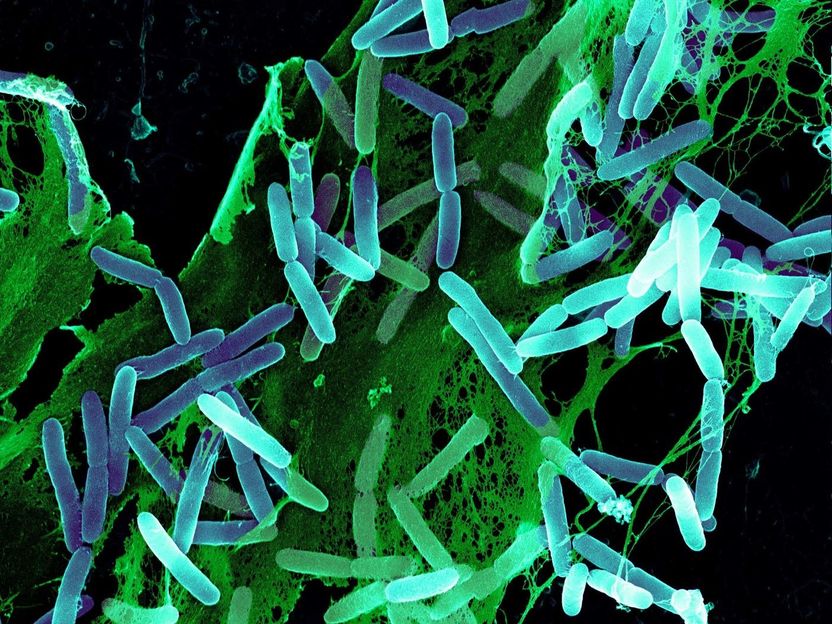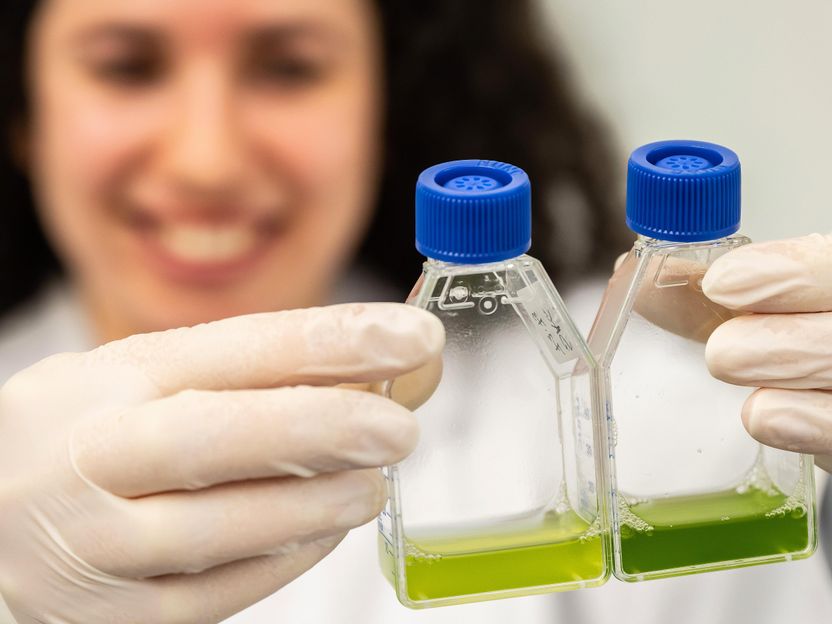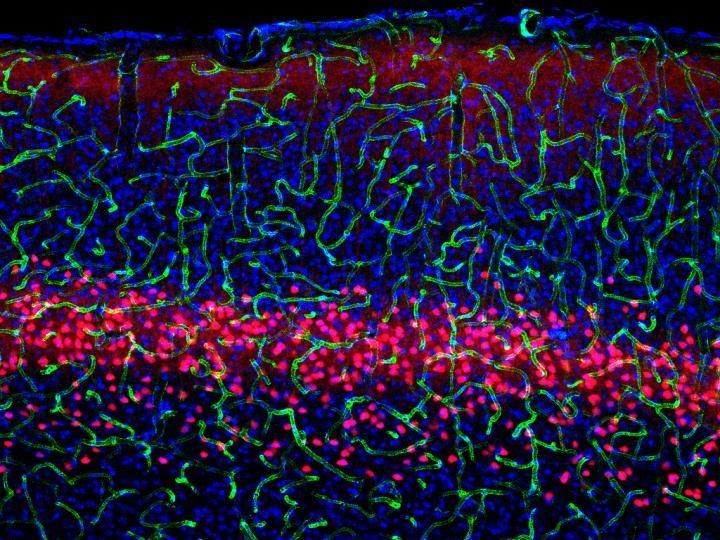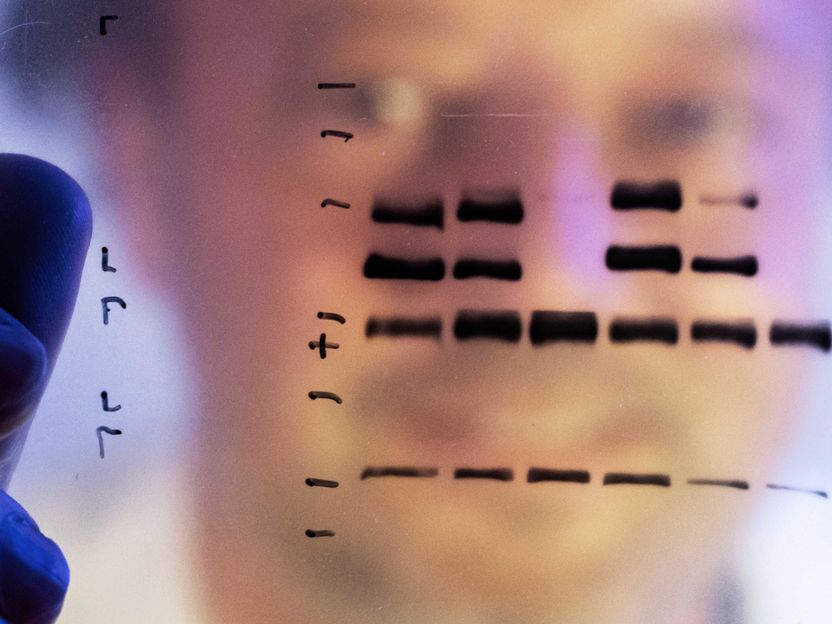Body cells spy out bacteria
The aryl-hydrocarbon receptor detects when bacteria increase so much in number that they become a danger to the body
Bacterial infection does not automatically lead to illness; many germs only become dangerous when they occur in large numbers. Researchers at the Max Planck Institute for Infection Biology in Berlin have discovered that the body has a receptor, which doesn’t recognize bacteria themselves, but spies out their communication. The body uses this to register when so many bacteria are present that they secrete illness-inducing substances known as virulence factors.

Pseudomonas bacteria under the electron microscope.
© MPIIB / Volker Brinkmann
In the case of opportunistic pathogens in our environment, this critical threshold for an infection is particularly high: only when they occur in very high numbers and/or form illness-inducing substances can they overwhelm a person.
Pseudomonas aeruginosa is one such germ. Everyone regularly comes into contact with it, as it is found predominantly in water pipes, wash basins and other similar places. However, large quantities of pseudomonads can cause serious illness. They do this by forming disease-inducing substances which enable them to gain a foothold in the host and cause damage. This germ can easily cause pneumonia, wound infections or bacteraemia and blood poisoning, particularly in hospital patients. These diseases are extraordinarily difficult to treat, as the bacteria are highly resistant to antibiotics.
How do germs decide when the time is right for an attack? They communicate with one another via small molecules known as ‘quorum sensing molecules’. Only when they have reached sufficient density do pseudomonads produce illness-inducing substances and mucous molecules, which defend them against antibiotics and the body’s own immune system. This makes sense for the germs, because as long as mucus and virulence factors are not needed, their production only means unnecessary energy consumption. On the other hand, the energy expenditure is worthwhile during an actual attack, because only then can they successfully infect the host and use it as a ‘breeding ground’.
Spotting communication among bacteria
Stefan Kaufmann and his team of researchers at the Max Planck Institute for Infection Biology have discovered that our body cells are able to spot communication amongst bacteria with the help of a receptor known as the aryl hydrocarbon receptor. This receptor detects the quorum sensing molecules, enabling body cells to detect when the bacteria are preparing for an attack. “Thanks to this spying, the body can activate the immune system in times of need to fend off an attack from these germs,” explains the study's lead author, Pedro Moura-Alves, currently a group leader at the Ludwig Institute for Cancer Research, Oxford University.
In fact, the receptor eavesdrops on the bacteria before they have even reached their quorum; detecting the early stages of quorum sensing molecules inhibits the aryl hydrocarbon receptor, blocking a premature mobilization of the immune defences. “This is effective for the host, as it saves energy to leave a small number of bacteria alone, provided they aren’t causing any damage. Only when they’ve reached a critical mass is the energy required for defence mustered,” says Stefan Kaufmann. This also helps prevent collateral damage caused by the immune system's response.
So our body not only recognizes whether germs are present or not. These recent results show that it also registers the way their numbers are growing, in order to react to differing stages of an infection.
Original publication
Pedro Moura-Alves et al.; "Host monitoring of quorum sensing during Pseudomonas aeruginosa infection"; Science; 20 December, 2019
Most read news
Original publication
Pedro Moura-Alves et al.; "Host monitoring of quorum sensing during Pseudomonas aeruginosa infection"; Science; 20 December, 2019
Topics
Organizations
Other news from the department science

Get the life science industry in your inbox
By submitting this form you agree that LUMITOS AG will send you the newsletter(s) selected above by email. Your data will not be passed on to third parties. Your data will be stored and processed in accordance with our data protection regulations. LUMITOS may contact you by email for the purpose of advertising or market and opinion surveys. You can revoke your consent at any time without giving reasons to LUMITOS AG, Ernst-Augustin-Str. 2, 12489 Berlin, Germany or by e-mail at revoke@lumitos.com with effect for the future. In addition, each email contains a link to unsubscribe from the corresponding newsletter.
More news from our other portals
Last viewed contents
Antibody slows tumor growth and metastasis in mice

Fitness needs the right timing - Molecular components of the endogenous clock in the green lineage

Interchim SAS - Montluçon, France
NattoPharma acquires MGP Diagnostics and secures rights to important patent

A look at the molecular quality assurance within cells - Researchers uncover how chaperones identify defective proteins

The hepatitis A virus is of animal origin - Researchers uncover the evolutionary origins of the global pathogen

Sensum d.o.o. - Ljubljana, Slovenia
AstraZeneca starts collaboration with start-up BenevolentAI - Collaboration will use artificial intelligence to discover potential new drugs
Dendreon utilizes pervasive antigen telomerase in new cancer immunotherapy - Preclinical results show significant survival benefit
WALDNER Laboreinrichtungen GmbH & Co. KG: Changes in the Management

Salk scientists discover the function and connections of 3 cell types in the brain



















































